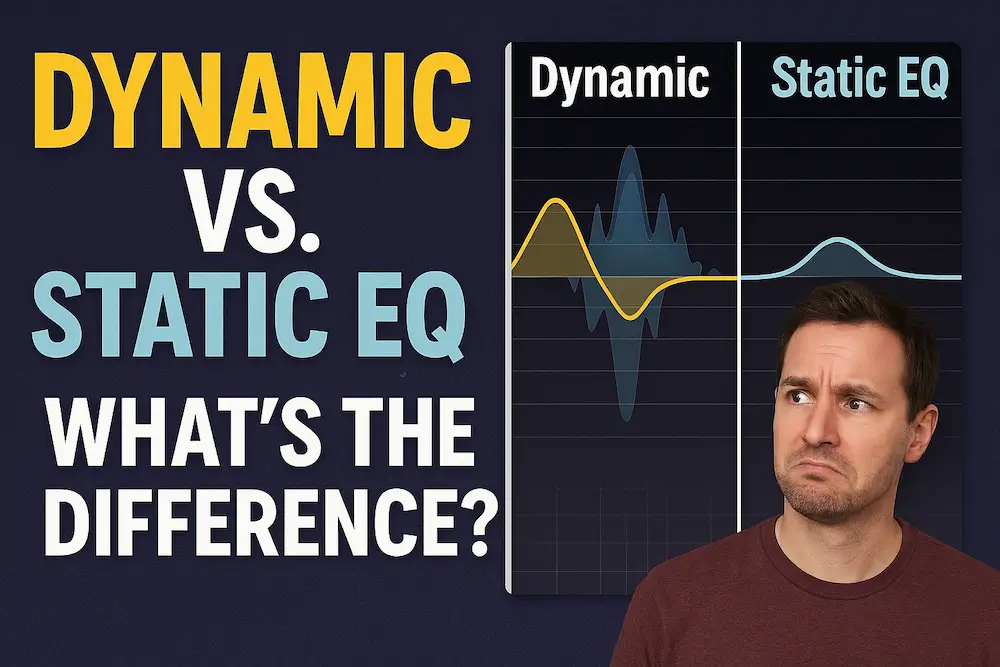Equalization, or EQ as we cool cats call it in the audio world, is basically the magic wand we use to tweak and transform how everything sounds. Whether you’re rocking out to your favorite jam or finessing your own tracks, EQ helps sculpt the sound to perfection. It’s that trusty tool in your audio toolbox to balance frequencies, giving everything you hear that sweet, sweet harmony.
Been around for a while, EQ has evolved big time since its beginnings. Back in the day, it started with hardware in dusty recording studios. Fast forward to now, we’ve got sleek software versions that let you play sound god at the click of a button. You get to boost the highs, cut the lows, or something in between. The choice is yours, and the canvas is just waiting for your artistic touch.
So, what about dynamic and static EQ? These are two main players on the EQ team, each with their own quirks and specialties. Dynamic is like your sound’s mood ring, changing as the sound does, while static is steady like a rock without any surprises. Getting the hang of both can seriously up your audio game, making your tracks sound pro level whether you’re an audio rookie or a seasoned mixer vet.
Understanding Static EQ: The All-Time Classic
Static EQ is like that reliable old friend who’s always got your back. It’s constant, consistent, and doesn’t budge once you set it. This type of EQ works on one frequency setting for your entire track, making it pretty straightforward to handle. You dial in your frequencies, decide how much you want to boost or cut, and voilà, it’s locked in place.
Within the static EQ realm, there are quite a few trusty types you might encounter. Think parametric, graphic, and shelving EQs, each offering its unique spin on frequency control. Parametric EQ, for example, is super versatile, giving you full control over frequency bandwidth and gain. On the other hand, graphic EQs are all about sliders, letting you adjust multiple frequencies at once to shape your sound the way you like.
When stability is key, turn to static EQ. It’s your go-to when the audio scene is stable and predictable. For instance, if you’re mastering a sweet podcast where the vocal tone doesn’t change much, static EQ is your best buddy. It’s perfect in live situations too, where setting and forgetting is not just convenient but necessary.
Static EQs have been a staple in many audio engineers’ toolboxes for years, and with good reason. They provide a level of control and ease that’s hard to beat, especially useful for those steady-as-you-go situations. So if you’re looking for tried-and-true audio solutions, static EQ has got the goods.
Dynamic EQ: Adapting to Your Audio Needs
Dynamic EQ is the shape-shifter of the audio world. It dances with the sound, adapting to changes in volume and frequency with grace. Instead of holding a fixed line, dynamic EQ adjusts based on the input signal, giving you more control over how your audio reacts to different situations. Imagine having an EQ that moves with the ebb and flow of your tracks—that’s dynamic EQ for you.
There are several types of dynamic EQs out there, each designed to tackle specific challenges. Whether it’s multiband compressors or frequency-specific processors, these tools grasp your audio’s nuances, adjusting on the fly to maintain balance. They’re especially useful when your tracks have dynamic ranges, with varying volumes and tones needing some extra care.
When stuff’s moving and shaking, dynamic EQ is your secret weapon. Think of live performances where vocals can shift from whispered verses to belted-out choruses or in recorded music where certain sounds need to breathe and others stay contained. Dynamic EQ shines in these situations, making sure nothing overshadows or gets lost.
For audio professionals and hobbyists alike, incorporating dynamic EQ can elevate your projects to new heights. It’s about embracing change, letting your sound morph naturally without losing its core. Experimenting with dynamic EQ allows for creative freedom, providing a safety net to manage those unpredictable audio elements. So, when you’re ready to explore new sound dimensions, dynamic EQ is your passport to the future of audio engineering.
Dynamic vs. Static: Choosing the Right Tool for the Job
When it comes to picking between dynamic and static EQs, it’s all about knowing what your music needs. Static EQ gives you consistent control, which is great for stable settings where you just want to set it and let it do its thing. In contrast, dynamic EQ is more like a responsive sidekick, ready to adapt as your audio shifts and swells.
The biggest difference lies in how they react. Static EQ sticks to the set parameters, perfect for when your sound is steady. Dynamic EQ, however, is constantly adjusting, providing flexibility in ever-changing audio environments. This distinction makes dynamic EQ a favorite when dealing with complex soundscapes bursting with highs and lows.
Each has its perks and drawbacks. Static EQ provides simplicity and reliability, whereas dynamic EQ offers adaptability and precision on the move. If your project is straightforward and consistent, static EQ is a safe bet. If you’re tackling a fluctuating mix with lots of peaks and valleys, dynamic EQ can smooth things out with style.
Figuring out which EQ to use isn’t just about the sound but also the context. Consider the demands of your session: Is it a live concert, a track mix, or a podcast edit? Each scenario may benefit from a different approach. If you’re adjusting frequencies once and sticking to them, static is the way to go. For fluctuating audio that demands nuance, dynamic is your match.
Being savvy with EQs can set your sound apart. It’s about matching the right tool to the job and knowing the strengths and limits of each EQ type. Whether you’re in the studio or at a live gig, understanding when to go static or dynamic can transform how you’re perceived as an audio professional.
Conclusion: Making the Most Out of EQ in Audio Production
Mastering EQ is a game-changer in the realm of audio production. Dynamic and static EQ each have their distinct vibes and functionalities, making them vital tools for sound engineering. Dynamic EQ offers that fluid, responsive edge, while static EQ provides reliable consistency. Choosing the right one can transform how you work your audio magic.
As technology keeps pushing the limits, the world of EQ is evolving with cool innovations and smart features. Staying updated with the latest trends can give you the edge, helping you tap into all the potential these tools have to offer.
Whether you’re a seasoned pro or just starting out, experimenting with different EQ types in various scenarios can really broaden your creative horizons. Dive into each track with curiosity and let your ears guide you. Identify what needs highlighting and what’s better off trimmed down for clarity.
Finding the perfect EQ balance enhances the listening experience, enabling your audio to connect with your audience on a deeper level. Be bold in your approach, trust your instincts, and remember: the perfect sound is the one that feels right to you and captivates your listeners.
Audio production is more than just technical know-how—it’s an art form. Let your EQ skills be the brushstrokes on your sonic canvas, crafting sounds that resonate and leave a lasting impact. Keep exploring and refining until you strike that perfect audio chord.
Related Posts:
- Free iZotope Ozone 11 EQ Quick Look
- Free Blindfold EQ By Audio Thing Quick Look
- Find Frequencies That Ruin Your Mixes RESO Quick Look
- FabFilter Pro Q4 FREE Alternative Download Today
Over 4 Million Sounds
Turn samples into songs with a versatile plugin suite. Loopcloud DRUM and Loopcloud PLAY craft pro‑quality beats and melodies that sound like you, and no one else.





Leave a Reply